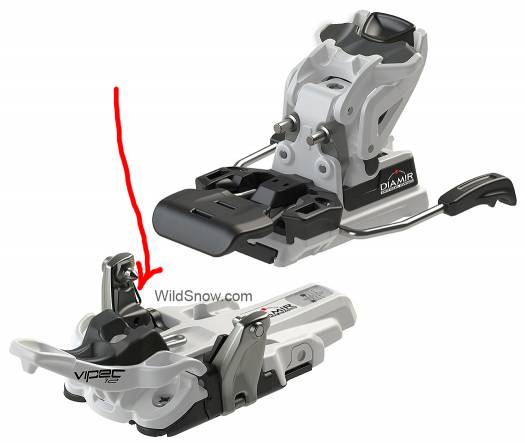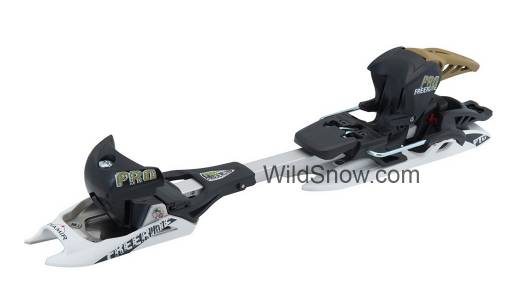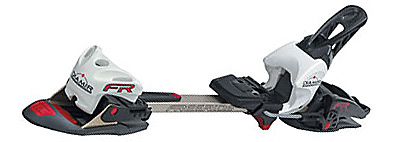Shop for Fritschi Bindings, all available models.
Frequently Asked Questions (FAQ), tricks, and tips about Fritschi Vipec, Diamir Titanal, Freeride, Explore, Express, Eagle, Freeride Pro and Scout “AT” randonnee backcountry ski bindings.

Fritschi Diamir Vipec ski touring binding 2014-2015, see our numerous Vipec posts and articles.
Shop for Fritschi Bindings, all available models.
Does Fritschi sell a tech or pintech binding?
Yes, in 2014 they released Vipec, a “frameless” ski touring and freeride touring binding based on the original Low-Tech (Dynafit) binding design but releasing to the side at the toe instead of the heel. See our complete Vipec binding coverage.
Are the safety brakes interchangeable between Fritschi frame binding models?
Yes. Be advised that two widths are sold (standard fits skis up to 86 mm, wide goes to 106mm, so pick the appropriate width for your skis.)

Fritschi Freeride Pro circa 2014. This state-of-art frame binding is receiving less attention now that Fritschi is producing their frameless Vipec binding. Yet the Freeride is still available and a viable option as of 20016-20017.

Fritschi Diamir Freeride Plus was released in 2006/2007, includes an improved heel unit as well as decorative red plastic that might give the binding a slightly more solid feel. This binding can still be acquired on the used market and is viable, though due to plastic age issues we’d recommend that by 2020 this model would be retired from all active use.

Fritschi Diamir Freeride (above) ruled the roost in 2004/2005 and is still a good bet on the used market, if you’re looking to stay on a budget.

Fritschi Diamir Explore is lighter and excellent for most skiers.

Fritschi Diamir Express is the same binding as the Explore, only with a different color scheme and was not made in long size.

Fritschi Scout is an affordable frame binding that was still available in 2016. It is suitable for occasional use by smaller to average size skiers, we do not recommend for expert skiers or heavy use.
I bought brakes, are they easy to install?
See this article.
How much do Fritschi frame bindings weigh?
The Freeride is sold with brakes, while the Explore/Express is sold without, so we weigh them that way. Note that with brakes, weights of all models are similar. We get all our weights by actually weighing items on a digital postal scale. Weights shown here may differ from other published weights, this could be due to manufacturing changes or publishing errors. If you see a weight that doesn’t look right, please contact us (use contact option on main menu). The following weights were verified by weighing actual production model bindings.
Freeride Plus:
72 ounces (pair, standard length, no straps, with standard brakes)
Freeride:
70 ounces (pair of 05/06 model with white toe/heel, standard length, no straps, with standard brakes, previous model with gray toe/heel weighs virtually the same)
Express/Explore:
61.7 ounces (pair, standard length, no brakes or straps)
Brakes, regular width (up to 86mm): 3.9 ounces each (05/06 model), 7.8 ounces/pair (previous year models are about one ounce heavier per pair)
What release value “DIN” settings do Fritschi Diamir bindings go to?
– Freeride: 4-12
– Express/Explore: 4-10
– Vipec: 5-12
Do I need to get a certain size Fritschi frame binding for my boot?
Yes, all Fritschi bindings are sold in three sizes (short,standard,long). To reduce weight and unwanted flex, use the shortest binding your boot will work in. Here are the numbers:
Freeride: Short 4.5-9/5.5–10 • Standard 6-12 • Long 12–13
Express/Explore: Short 4-7.5/5.5–9.5 • Standard 7.5-12/10 • Long 11–13/NA (Express not available in long size)
Can you explain which bindings match in mounting screw patterns, and which do not?
Simple. Eagle and Freeride PRO use one pattern, all others use another (older) pattern.
Someone wants to buy my bindings mail-order, how do we know their boots will fit for sure?
For a rough idea of this, see above. To be more specific: Yes, all Fritschi bindings do come in different sizes, and the range of boot sizes a binding fits is indicated by the numbers printed on the binding rail, which show just behind the heel unit of the binding. These indicate the length of the boot sole in millimeters. So, find out what your friends boot sole length is, and look for a number in that range on the rear of your binding rail. If you see a number on the binding rail that’s close to their boot sole length, then you’re all set to make the sale. Know that some of the numbers will be under the heel unit, so you may have to move it forward or back to see them all. Also, to save time known that many boots have the sole length printed on the shell, somewhere on the side of the heel.
Can I use my Fritschi bindings at the ski resort?
Using your randonnee ski touring bindings for all your skiing, resort and backcountry, is known as “one rig” or “quiver of one.” The wisdom of using bindings as “one rig” depends on a few factors. If you’re primarily doing laps using ski lifts you’ll be covering an immense amount of vertical that places wear on the bindings they were not designed for. More, though the Fritschi toe release is adequate, it’s not as highly engineered as the latest alpine bindings. Thus, if you’re only using the lifts for access to the backcountry, by all means use any of the Fritschi models, but if you’re simply riding ski lifts and charging max vertical inside the ski area, a full-on alpine rig is probably safer and more durable (more vertical = more chances of falling and needing release). As for which model binding to choose for your “one rig,” use a Freeride if you’re larger or aggressive, for smaller or more mellow skiers, the Explore/Express will work fine.
What about ramp angle, is that why I feel like I’m in the back seat when I use Diamirs?
Ramp angle, otherwise known as “delta,” is the difference in height between boot toe and heel. If your toe is lower than your heel, you’re said to have “positive ramp angle.” Most skiers like a few degrees positive ramp angle, or at least a neutral angle (heel/toe at equal heights). All Fritschi bindings lack much in the way of positive ramp angle. If you need more ramp angle, most people can get enough delta by eliminating the shim under the toe unit of Fritschi bindings. If this doesn’t yield enough ramp, you can shim up the rear of the binding with a custom made plastic spacer. If you use different bindings and boots, try to adjust all your ramp angles so they’re similar — I believe most complaints about ramp angle come more from folks switching between different boot/binding combos. If you’re used to one setup and change to something with significantly more or less ramp, you’ll feel a huge difference you’ll most often dislike. If you use one setup exclusively, you can get used to just about anything.
Can I shorten the bar on Fritschi bindings so they’ll work with smaller feet?
Sorry, not likely. Do it yourselfers have accomplished this, but the bar connecting the toe and heel units of all Fritschi backcountry skiing bindings has machined slots near both ends that would end up where you’d cut the bar to make any significant length change.
Fritschi bindings are kind of pricey, can I play on a budget?
Yes. If you need Freeride bindings look for them on the used market. Search web forums and Ebay. If you don’t need the beef of a Freeride the older Diamir Titanal 3 is a good alternative and may still available on the retail market. T3 is not in production, however, so it’s somewhat of an “orphan” product. Earlier Titanal bindings had a few durability problems, so buy nothing earlier than the “3,” which can be identified by the dark blue plastic of the toe jaw and heel unit, as well as a “T3” logo printed on the toe jaw.
How do you adjust the forward pressure setting on Fritschi frame bindings?
First do a rough adjustment of length so that your boot snaps in and looks like it’s correctly held (if possible, use boot sole length in millimeters and set binding to corresponding number that shows on rail just behind heel unit.) Length adjustment is done with the screw at back end of the binding rail. Next, with the boot in the binding, adjust the length screw a few turns in or out so that it’s exactly flush with the rear surface of the rail. Take care to get this right. Too much forward pressure may cause the toe unit to break off the binding, while too little will cause pre-release.
Can I mount on my skis on my garage workbench?
Sure, see our how-to.
How do Fritschi bindings work, can I take a look inside?
They’re ingenious. Check out this Fritschi internals blog post.

